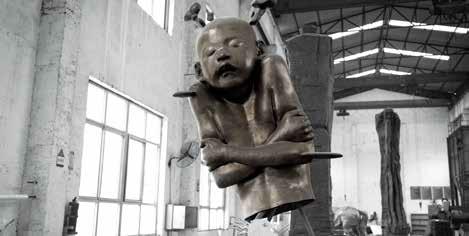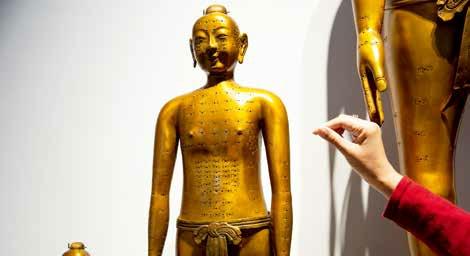Bronze County
2020-02-04byZoeZhao
by Zoe Zhao
Fully-equipped in goggles and a protective mask, Xue Ning was polishing an unfinished bronze figurine of Guan Yu, a renowned general of the late Eastern Han Dynasty (25-220) and the early Three Kingdoms period(220-280) who has been deified in China and the broader East and Southeast Asia. Holding the figurine in his left hand, Xue held an emery wheel in the other hand to polish it. He stopped periodically to check his work.
A bronze craftsman working in Xiaxian County, Yuncheng City of Shanxi Province in northern China, Xue is employed by Shanxi Yuda Group. “The process of making bronze craftworks requires far more than just simple techniques,” Xue said. “It involves coordinating and managing myriad complex processes.” With 20 years of working experience, the veteran craftsman emphasized “the complicated process” repeatedly when describing his work.
Usually, production of a bronze craftwork starts with designing a clay mold. Molds are produced according to specific requirements of different pieces requiring different techniques. Nearly 20 steps follow, including sand blasting, processing, refining, surface treatment, packaging, and storage.
Throughout history, Xiaxian County has developed a rich bronze culture. A population of around 370,000 inhabits the small county of less than 1,400 square kilometers at the convergence of northern China, northwestern China, and Chinas central plains. Some historians believe that around the 21st century B.C., the Xia Dynasty (2100-1600 B.C.), Chinas first recorded hereditary dynasty, made Xiaxian its capital. Archeological excavations have provided evidence that bronze culture in Xiaxian dates back at least 4,000 years. Many bronze tools and weapons were unearthed at the Dongxiafeng site that covers an area of about 250,000 square meters. With the help of radiocarbon technology, archeologists dated those tools and weapons to around 1900 to 1500 B.C., showing that the county had already been deep into the Bronze Age by that time.
From small bronze gifts to life-size bronze sculptures, many enterprises in Xiaxian County have developed operations along the bronze culture industrial chain. Shanxi Yuda Group is a prime example. In addition to producing bronze sculptures, ornaments, and gifts, it has established an expo park to further promote bronze culture.

Local companies involved in bronze craftwork production have benefited so greatly from rapid development of science and technology that they are now looking to the global market. They have embraced innovative methods such as smart casting, digital design and production modeling, 3D printing, and e-commerce to promote Chinese bronze culture globally.